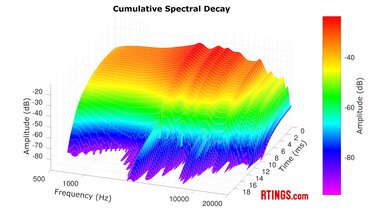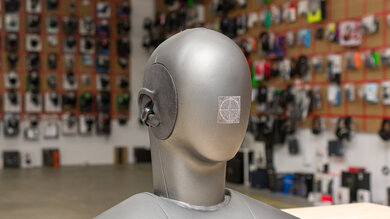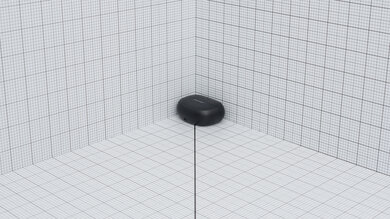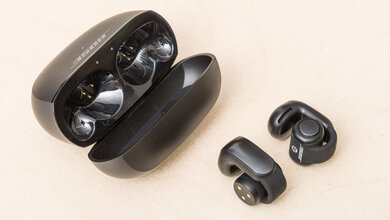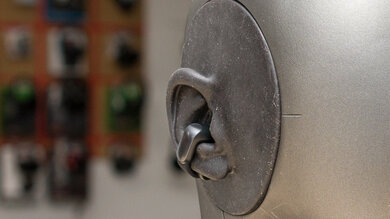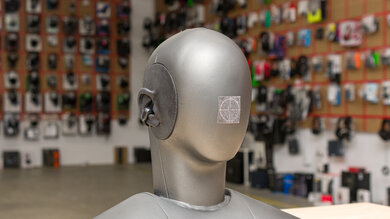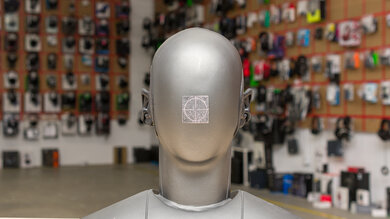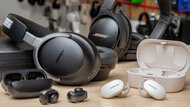The Bose Ultra Open Earbuds belong to the relatively new category of open-fit headphones meant to tackle the desire of folks who want to experience natural-sounding environmental awareness while listening to music. While it's pretty clear why you'd want to block out the world in most scenarios, like on the bus, there's good reason to want to hear it sometimes, too. If you're an outdoor runner, work in collaborative spaces, take night walks, or need music to motivate you at team practice, these all suit open earbuds. These cuff-like earbuds represent the next generation of Bose open-fit designs and offer a novel solution by clipping onto the bottom of your ears while keeping the canals open. Let's see where they shine and if there are any trade-offs to this new style of open-fitting earbuds.
Our Verdict
The Bose Ultra Open Earbuds are great for sports and fitness. Their remarkably stable fit ensures the clip-on buds won't fall off during dynamic movements like cross-fit or running. Since the sizing adjusts to fit around your ear lobes and their silicone housing that makes contact with your skin has a little give, they feel comfortable on most people. Their lightweight and portable design makes them easy to take with you to the gym, and the IPX4 rating resists minor water splashes. That said, their open-fit means you're always hearing your surroundings, which is ideal for situational awareness, but this design lacks the versatility of noise cancelling earbuds with transparency modes that let you choose based on your needs. This open-fit design also means they lack much bass oomph, though if you listen to podcasts or audiobooks, the bright sound signature works well for voices.
-
Portable design.
-
Open design allows you to hear the environment.
-
Comfortable fit.
-
Very stable fit.
-
Poor bass reproduction.
The Bose Ultra Open Earbuds are poor for travel. Their open-fit design means your trip won't have the luxury of active noise cancellation to isolate you from engine rumble or passenger chit-chat, making it difficult to focus on what you're listening to. That said, the buds feel comfortable, and their battery life is long enough to last through most trips without a recharge. Plus, you can easily stash them in your pocket when not in use.
-
Portable design.
-
Almost zero noise isolation.
-
Poor bass reproduction.
The Bose Ultra Open Earbuds are poor for office work. Your audio will be constantly leaking into the space, and the absence of noise isolation means you'll hear everything in your environment, which may be preferred in collaborative spaces. However, if your goal is noise isolation to focus on your work, the open-fit doesn't facilitate that. Still, they're comfortable, and their mic means you can use them for online meetings. While your music won't sound full due to the bass roll-off, they playback voices well.
-
Comfortable fit.
-
Almost zero noise isolation.
-
Poor bass reproduction.
-
Only basic call controls.
The Bose Ultra Open Earbuds are disappointing for wireless gaming, and because they're Bluetooth-only, their connectivity is limited and high latency.
The Bose Ultra Open Earbuds are wireless earbuds only and can't be used for wired gaming.
The Bose Ultra Open Earbuds are poor for audio reproduction accuracy. Their bright sound signature produces an even mid-range and slightly uneven top-end, but the open-fit design strongly rolls off the low-end from your audio. This means your audio content sounds incomplete and lacking bass. Still, they playback voices and melodies with clarity, but accuracy across the audible frequency range isn't the priority of the open-fit buds. They're well-matched in the L/R drivers, but their group delay is terrible, in part because they scarcely reproduce bass.
The Bose Ultra Open Earbuds are awful for noise isolation. Their design leaves your ears unsealed and open to hearing everything in the environment, from nearby conversation to construction. This is intentional and meant for folks seeking environmental awareness. They also leak a thin-sounding version of your audio that people nearby can hear.
The Bose Ultra Open Earbuds are decent for microphone use. They capture a somewhat natural-sounding version of your voice and separate it from background noises satisfactorily. Because your ears are unsealed, you'll also hear everything in your environment during calls.
The Bose Ultra Open Earbuds have passable frequency response consistency. Because they clip onto your ear lobes, it's quite possible to place them poorly if you're not careful and as a result, end up with a different sound between wears and on each side. There is variation present in the high treble, which is more prominent between sessions. With that said, other inconsistencies are in the regions that these don't really reproduce much of, such as the low and mid-bass frequencies, so it's not truly as bad as it seems.
- 8.2 Sports And Fitness
- 4.5 Travel
- 4.6 Office Work
- 5.1 Wireless Gaming (In Development)
- 4.9 Wired Gaming (In Development)
Performance Usages
- 5.4 Audio Reproduction Accuracy
- 0.9 Noise Isolation
- 7.0 Microphone (In Development)
- 6.1 Frequency Response Consistency
Changelog
-
Updated Jun 10, 2025:
We referenced the SoundPeats PearlClip Pro in the Portability box.
-
Updated Apr 25, 2025:
This review has been updated to Test Bench 2.0, which adds the following tests: Stereo Mismatch, Group Delay, Cumulative Spectral Decay, PRTF, Harmonic Distortion, and Electrical Aspects. We've added new performance usages and updated the text throughout the Sound tests and side-by-sides.
- Updated Apr 25, 2025: We've converted this review to Test Bench 2.0, which updates our sound tests and adds performance usages. You can read more about this in our changelog.
-
Updated Nov 26, 2024:
Bose just released seven new colorways for these headphones, so we've updated our review accordingly.
-
Updated Nov 20, 2024:
The Compared To Other Headphones box has been updated to mention the Apple AirPods 4 Truly Wireless.
Check Price
Differences Between Sizes And Variants
The Bose Ultra Open Earbuds come in nine standard colors: 'Black,' 'White Smoke,' 'Carbon Blue,' 'Diamond 60th Edition,' 'Sunset Iridescent,' 'Chilled Lilac,' 'Lunar Blue,' 'Sandstone,' and 'Moonstone Blue.' Our unit is 'Black,' and you can see their label here.
The manufacturer collaborated with Kith, the New York City designer, on a co-branded version. There's also a multi-colored limited edition version made in partnership with musician Steve Lacy, but that's hard to find. Let us know in the comments if you know of any other variants.
Compared To Other Headphones
Bose has invested in a few different, open-fit designs predating the Bose Ultra Open Earbuds, like the combination sunglasses-headphones Bose OpenAudio Frames line. However, not everyone wants to wear sunglasses to listen to audio. The Ultra Open Earbuds' unusual clip-on style pivots towards open-fits with improved functionality for everyone. Although there have also been conventional open-fits, including the previous generation, Bose Sport Open Earbuds Truly Wireless, their case doesn't store any battery charges, and they lack the Ultra Open's virtual surround sound support. Alternatively, bone conduction headsets also offer environmental awareness, like the Shokz OpenRun Pro Bone Conduction. Not everyone will like the bone-conducting sensation, though. It's worth considering the Anker Soundcore C30i if the clip-on design appeals to you, but the Bose premium is a barrier. Still, the popularity of the unsealed, stemmed buds like the Apple AirPods 4 isn't unfounded, and they're worth a look if you have an iOS device and because they output a more balanced bass response than the Bose.
Check out the best wireless earbuds for running and working out and the best wireless Bluetooth earbuds if you need something with different features like noise cancelling. Finally, dive into the best Bose headphones for a fuller picture of their headphones.
The Bose Ultra Open Earbuds are slightly better for most people than the Shokz OpenRun Pro 2 Bone Conduction, but each have loyal fans. The Bose are more portable and don't apply pressure near your cheekbones and temples, which can bother some people. Their continuous battery life is comparable to the Shokz, but the extra recharges the case provide edge them ahead. They're also slightly more stable. On the other hand, the Shokz headset has a tougher IP55 rating and multi-device pairing, and it won't get in the way if you have a lot of piercings along your ear lobes. While the Bose are well-built, the silicone and nickel-titanium frame of the Shokz seems more impervious to damage.
The Bose Ultra Open Earbuds and Shokz OpenFit True Wireless fit very differently, but both provide unsealed fits for hearing your surroundings, resulting in negligible bass reproduction. The Bose clip on the bottom of your ears and their fit is a more stable solution. Their battery life is longer if you don't enable the included virtual surround sound. The Shokz fit with silicone-covered hooks over your ears, which is stable but not as stable as the Bose. They also have a greater IP rating, as they're certified for dust resistance. That said, given that these two sets of buds are similarly spec'd, your choice will likely depend on your fit preferences.
The Bose Ultra Open Earbuds and Sony LinkBuds Truly Wireless are unusual-looking earbuds designed to prioritize environmental awareness. Both have virtual surround sound and IPX4 ratings against water splashes. Neither pair has much bass on tap. The Bose feel more comfortable and stable. Their battery lasts longer, too. The Sony buds still sit in your ears, which can give you a slightly more consistent sound, especially if you have ear piercings. Their mic system sounds a bit better, but neither is pro quality. They use touch controls and include a handy Speak-to-Chat function to pause playback automatically if you're engaged in a conversation.
The Bose Ultra Open Earbuds are a bit better cuff-like buds than the Anker Soundcore C30i, but the tier difference is enough to reasonably steer many people toward the latter. These niche designs prioritize awareness above sound quality, so they both sound bright without isolation. The Bose are more comfortable because their flexible hinge adjusts to your ear's shape better, which allows for longer listening sessions. They leak less audio, so you don't annoy people nearby, and their mic sounds a bit better. They're less prone to command misfires, too. On the other hand, the Anker's battery is longer, and they fulfill the necessities like stability and build quality nearly as well as the Bose. Their mic sounds more distorted, though.
The Bose Ultra Open Earbuds are better open-fit workout earbuds than the Shokz OpenFit Air. The Bose are more comfortable and stable and their continuous battery life is three hours longer. That said, the Bose are much more expensive than the Shokz, and they don't support multi-device pairing.
The Shokz OpenRun Bone Conduction headset is a different solution to environmental awareness than the Bose Ultra Open Earbuds. The Shokz use a titanium frame covered in silicone that bypasses the ear canal. They have a higher IP rating with more dedicated buttons for each function. They're larger and use a proprietary charging cable. While they have a comparably minimal amount of low-end, they have a less consistent frequency response. The Bose are more portable and clip on your ears. They use one button for all the controls on each bud. Their battery life is shorter unless you include the case's recharges. Unlike the Shokz, you get a companion app for virtual surround sound, EQ, and updates. They use a standard USB-C to charge up.
The Bose Ultra Open Earbuds are better open-fit buds than the SoundPeats PearlClip Pro. But that makes sense as the Bose are many times more expensive. As is natural with open-fit buds, both pairs lack bass and are better suited to speech-based content, but the Bose have a flatter, more balanced sound, while the SoundPeats can render voices a little harsh or honky. The Bose also have a longer continuous battery life. Still, their microphones perform very similarly. Ultimately, the choice between these two will likely come down to budget, and it's notable that the SoundPeats put up a good fight against their much more expensive rival.
The Bose Ultra Open Earbuds and the Apple AirPods 4 with Active Noise Cancellation are both open-back wireless earbuds, but the similarities mostly end here. The Bose will appeal to the fitness crowd, who value being able to hear their surroundings. They're more comfortable, and their wraparound fit provides greater stability. The Bose also have a significantly longer continuous battery life, at almost 10 hours. The Apple, by comparison, have a one-size-fits-all design that sits lightly in your ear canal. They come equipped with a decent ANC system that helps block out outside noise but can also filter in some external noise using 'Transparency' mode. They have a significantly more bass-heavy sound that helps bring out the kicks and basslines in electronic music.
The Bose Ultra Open Earbuds represent the next generation of the Bose Sport Open Earbuds Truly Wireless. Both have similarly long-lasting batteries and IPX4 ratings. The Ultra Open Earbuds are a completely different fitting design that clips on the bottom of your ears and is very stable. They sound brighter by default and have a virtual surround sound function in-app. The Sport Open Earbuds use a less comfortable and not quite as stable over-ear hook design. Their sound isn't as piercing in the highs. They also lack high-quality aptX Adaptive codecs, virtual surround sound, as well as a graphic EQ and presets in their companion app.
Video
Test Results
The Bose Ultra Open Earbuds have a very bright default sound. Part of that is attributable to their open fit that sits outside your ear canal. How they sound depends greatly on how much your environment competes with what you're listening to with the buds. Their tuning works for any spoken content like podcasts or classical, folk, and vocal-centric pop music without a lot of bass content. By design, these can't adequately reproduce a full bass with deep, rumbling low and mid-bass frequencies well enough to balance their bright voicing.
You can use the in-app EQ to turn down the treble, although it's limited to three bands and has imprecise labels like 'treble'.
These headphones have a high noise floor, which is noticeable if you're in a quiet environment. It's most prominent when audio content is playing, and if you pause it, you'll hear the hiss continue for a couple of seconds before disappearing until you play audio again. It seems like our left bud also has a louder noise floor than our right bud. External noise, like a busy street, can help mask the sound.
Their frequency response consistency depends on your ability to get each to have the same ear placement. Due to their unique fit, you can move them around more than conventional earbuds. If they sit differently on each ear, it'll impact the delivery of consistent treble and bass. Since not everyone has identically shaped ears, you'll want to listen for consistency, too.
While it looks like they're inconsistent in the bass frequencies because they barely reproduce much lower than the high-bass register (which is quite consistent), it doesn't make much difference, effectively. Mids are very consistent between placements. Treble is delivered with some inconsistencies, which is pretty normal.
Weak bass is one of the disadvantages of this style of open-fitting earbuds, and, as a result, these buds do a terrible job of complying with our bass response target. You'll hear the initial strike of a kick drum and pluck of a bass string in post-punk songs like Transmission by Joy Division, but they lack body, punch, and rumbly substance. Those who are in search of open-back buds with better bass extension will have more luck with the Apple AirPods 4 with Active Noise Cancellation.
The Bose Ultra Open Earbuds do a remarkable job with mid-range target compliance. When it comes to reproducing mid-range frequencies these have a smooth mid-range voicing that doesn't significantly exaggerate any ranges. Lead instruments like guitars and keyboards sound clear and natural. Spoken voices in podcasts and audiobooks come through true-to-life.
The Bose Ultra Open Earbuds' compliance with our treble target is passable. Most of the range is a bit uneven. The harmonics of cymbals, vocals, and S and T sounds sound detailed, crisp, and shrill. You can adjust the 'Treble' slider in the app's equalizer to taste, although it's not a very granular EQ.
These headphones have a sub-par peaks and dips performance. Unsurprisingly, there are a few peaks/dips in the bass range, including a large peak in the low bass; these headphones already have some trouble reproducing this range. These peaks/dips in the bass won't impact your listening experience too much overall, considering they lack bass anyhow.
The mids are very smooth relative to the buds' bright and balanced tuning, so lead parts like synths and guitars sound natural on the whole. The treble range features some sharper deviations from the sound signature, with a series of small peaks and dips in the low-treble that add harshness or dullness that can cause fatigue from cymbal hits. Similarly, the mid-treble is slightly piercing and a touch uneven too. There are some large peaks and dips in the high-treble range, which can sound airy, but we lose sensitivity to this range over time, so you may or may not notice these peaks and dips as much.
These have excellent stereo mismatch performance. Each driver is well-matched for the weighted amplitude. There's a weighted frequency response, with the greatest deviation mainly in the high-treble at the threshold of human hearing. The same can be said of the phase response mismatch, which sees a spike in the high-treble region. Due to the unique fit of these ear cuffs, you'll want to pay attention to their placement, as that can alter how you perceive the stereo image in the treble, particularly.
The Bose Ultra Open Earbuds have awful group delay performance. Because these severely roll-off bass frequencies in their sound profile due to their design's limitations, this result isn't surprising. How you experience the bass range's group delay is unlikely as dramatic as the score suggests considering that these barely output much low-end anyway. Since their frequency response is much more mid-rangey and trebly than bassy, they output a much more transparent signal in those regions.
These have reasonable harmonic distortion. Due to their bright sound signature, they barely playback bass frequencies, so harmonic distortion in that region doesn't hinder the purity of the signal. At 94 dB/SPL and 104 dB/SPL, each frequency is played back cleanly for the most part.
These are Bluetooth earbuds, so they don't need an amp to drive them.
Their virtual soundstage is accessible through the companion app. The manufacturer calls the surround sound mode 'Immersive Audio.' This essentially applies digital signal processing (DSP) to force conventional stereo mixes into a simulated virtual surround sound. It's similar to Apple's Spatialize function (not to be confused with Spatial Audio). Unlike other surround sound implementations, like Sony 360 Reality Audio and Apple Spatial Audio, this effect doesn't require your audio to be specifically mixed by an engineer or producer in surround sound formats like Dolby Atmos.
You get two basic modes: one that applies the algorithm to force your audio into Immersive Audio, which holds the center of the surround sound effect in a static position. The other mode adjusts the surround effect with head-tracking relative to where you are and the virtual 'center' of the audio. The effect works pretty well and is immersive for content like live concert recordings, and it's fun to try on old mono recordings. Still, it's DSP, so it works better on some songs than others because a producer isn't making the final mixing decisions. However, since not all of your favorite tunes will receive a dedicated Dolby Atmos mixing treatment, the DSP effect of Immersive Audio is a close approximation.
These are the settings used to test these headphones. Our results are only valid when using them in this configuration.
The manufacturer's take on what open earbuds look like and how they fit is unique. While their previous effort, the Bose Sport Open Earbuds Truly Wireless, align with the current slew of over-ear hooked unsealed wireless earbuds, the Bose Ultra Open Earbuds are a completely different take on open fits. Rather than hooking over the top of your ears, they clamp just above your ear lobe around the bottom of the helix, antihelix, and pinna, sort of like oversized and sporty clip-on earrings.
The open earbuds are made of plastic and silicone and come in two standard colors, 'Black' and 'White Smoke'. In addition, Bose collaborated with the clothing company Kith to create a branded version in black. The Steve Lacy signature model features the boldest color departure. These have green buttons, with one bud in cream and the other in a darker earth tone. These come with a matching two-tone case with dark magenta branding.
The Bose Ultra Open Earbuds are impressively comfortable. They feel good thanks to their lightweight, small size, and nearly universal sizing. They take some getting used to, though, and initially, dialing in the placement feels strange, but you can adjust where they sit along your ear, so if you wear earrings, you can work around them. Wearing them for long periods can eventually fatigue the pinna of each ear, and if you exercise, they can heat up slightly. On the bright side, glasses don't get in the way like they can with over-ear hooks commonly found on fitness earbuds.
The Bose Ultra Open controls are okay. Essentially, you've got a single, clicky button on each bud for all of your controls, which is intuitive but inherently limited in commands. They emit sounds to signal they're powered on when you take them out of their case, to alert you if you've maxed out or minimized the volume, and there are voice prompts. They don't make sounds when you use playback controls like pause, play, and track skipping. All the commands work well except for volume adjustments, which have a narrow window of time for getting the level you want without over or under-shooting how long you need to hold the button down.
You can assign each earbud one preset function per side through the companion app, called 'shortcuts,' like cycling through Immersive Audio settings and accessing your voice assistant. We experienced issues remapping controls when we placed the buds back into their carrying case. This action caused the buds to forget the remapped commands, so it can be frustrating if you're constantly losing your saved setup.
Multi-function button:
- Press and hold: Power on/off.
- Press and hold from powered off: Turn on and initiate Bluetooth pairing.
- Single press: Pause/play, answer call/answer a new incoming call (while you're already on a call).
- Double press: Skip to next track, end call/decline incoming call
- Double-press-and-hold: Increase volume on the right earbud, decrease volume on the left earbud.
- Hold: One assignable function for each bud.
The Bose Ultra Open Earbuds are exceptionally portable. Like the SoundPeats PearlClip Pro, you'll still want to use their case to store them, but they take up very little space.
Their charging case is good. It's similar in looks and build to other true wireless cases by the brand, with magnets to hold the buds in place to charge. Its materials are semi-matte plastic. The plastic hinge noticeably shifts laterally, which doesn't instill confidence in its long-term durability. For premium earbuds, it's somewhat surprising the case doesn't charge wirelessly. However, it charges via the USB-C port on the rounded bottom of the case.
The Bose Ultra Open Earbuds' build quality is good. Their plastic housings and the buttons feel solid. The open-fitting buds have an IPX4 rating to protect against light splashes, but the case doesn't. As with most designs, their potential points of weakness are the hinges. The flexible silicone that loops each cuff-like bud around your ear has the potential to tear or weaken over time, as does the internal cabling that routes through the silicone loop. Similarly, the plastic hinge on the case has a noticeable amount of give, and the lid shifts around somewhat.
The Bose Ultra Open Earbuds are incredibly stable. They overcome some of the fit-related shortcomings of conventional true wireless designs. For example, by not needing different-sized ear tips to obtain a good fit—and fit still varies from person to person, even when you get a huge selection of ear tips—this wraparound shape is more predictably stable. You can successfully perform jumping jacks, push-ups, or go for runs without needing to adjust them. These are great if you have trouble getting earbuds to stay put.
The noise isolation of these open-fit earbuds is awful, which is a feature and not a bug. Their goal is to leave your ears open so that you can stay aware of your environment while still listening to your audio. As a result, virtually anything you can hear normally can still be heard with these on, so rumbling bus engines, traffic, chatter, and café clatter all reach your ears. If you're out running or working in a collaborative office space, you can seamlessly hear what's important without pausing your music.
In the app's settings, you can also select that the volume you listen at automatically adjusts to your surroundings' noise level. This feature isn't unique to open-fit earbuds, and you can find it in products like the Google Pixel Buds A-Series. Still, it offers more utility with earbuds that totally lack isolation because your audio contends with even more external sounds.
True to their design, the Bose Ultra Open Earbuds allow you to hear everything in your environment because they have virtually no isolating qualities. If you're outside on the street for a run, this open-fit keeps you completely aware of your surroundings. However, they're a terrible choice for ignoring passengers and ambient din on a flight or focusing on work in a busy office.
The Bose Ultra Open Earbuds have a decent leakage performance. Leakage is mostly concentrated in the treble range, so escaping audio sounds thin but is audible, even if you're in a moderately noisy environment, like an office.
The Bose Ultra Open Earbuds' microphone recording quality is alright. As of firmware update 4.0.22, the mic sound quality has improved. Your voice sounds a bit too bright, but overall, there's a somewhat balanced midrange, so you sound mostly true-to-life.
The microphone system's noise handling is decent. Firmware 4.0.22 improves the noise handling a bit. With constant background noise, the mic prioritizes your voice and doesn't dramatically impact the clarity of your speech. Background voices are filtered well, though some of the high frequencies of your voice are also removed. It also suppresses the sudden loud noise well without greatly obscuring your voice.
These have a very good battery performance. The manufacturer states that they have a 7.5-hour battery life, and our unit lasts for 9.5 hours of continuous audio on a single charge. Your results may vary based on factors like how loud you listen to your music, and since the manufacturer states these will last 4.5 hours when you listen using Immersive Audio mode, it'll depend on which mode you're using.
Their charging case holds just under three extra charges, and they take less than an hour to charge up fully. Interestingly, the case doesn't have wireless charging compatibility and only uses USB-C. To help conserve battery life, they also feature an auto-off timer. That said, if you want even better battery life from clip-on earbuds, check out the Anker Soundcore C30i.
The Bose Music app is decent, but it has a couple of issues. Its interface is clean and easy to navigate with solid features, have a look at it here. There's Immersive Audio, a DSP-based virtual surround sound effect with head-tracking. You can control the somewhat limited three-band equalizer with presets and playback and volume controls. You get 'shortcuts,' which are assignable commands for the press-and-hold command on the buds. In the app, you can monitor battery levels and access firmware updates. The manufacturer typically rolls out new features to existing products through these firmware updates.
Unfortunately, connecting to the app can also cause the buds to disconnect or take time for the app to search for them. You can erase the app cache and re-pair the buds as one solution, but it doesn't completely solve things since the issue could still happen again. We didn't experience this issue on all phones, though, and noticed it on the Samsung S24 Ultra, so your experience may vary.
We also noticed that the controls would reset after you placed the buds back into the case. While you can remap controls to your liking in the app, if you lose these settings by using the carrying case, it can be a dealbreaker.
These headphones have a USB-A to USB-C cable for charging their case's battery. You can't listen to these with a wired connection.
The Bose Ultra Open Earbuds have alright Bluetooth connectivity. They use Bluetooth 5.3 with a good selection of codecs, including aptX Adaptive (High Quality and Low Latency). AptX Adaptive (Low Latency) can still cause a bit of lag to audio when watching videos, but not a huge amount. Latency varies from device to device, and some apps compensate for that. aptX Adaptive (High Quality) offers high-quality audio, although whether you can truly detect the quality difference depends on how noisy your environment is. They don't have quick pairing, and at launch, they don't come with multi-pair capabilities, although Bose indicates that will change in a later firmware update.
The Bose Ultra Open Earbuds can connect to computers that have Bluetooth compatibility. Full audio and microphone support is available.
These Bluetooth earbuds can't connect to PlayStation consoles.
Comments
Bose Ultra Open Earbuds: Main Discussion
Let us know why you want us to review the product here, or encourage others to vote for this product.
Update: We referenced the SoundPeats PearlClip Pro in the Portability box.
- 21010
My Experience-Bose Ultra Open Earbuds:
Sound - superb. Crystal clear and good volume. Love the immersive option. Making and receiving phone calls- Excellent. Much better than most phone-capable earbuds. Microphone works very well. People I am talking to are pleasantly surprised when I tell them I am speaking on these earbuds. Battery life - adequate. “Fit” - poor. Yes they are comfortable. But NOT for sports or other active movements like climbing or descending stairs. They constantly fall out of my ear despite being fitted as recommended and adjusted,
Great for sitting at a desk for use like a hands-free speakerphone or listening to music . For sports, bicycling etc.? Forget it.
Edited 3 months ago: Needed to emphasize conclusion This product has been merged with Bose Ultra Open Earbuds with Immersive Audio, Open. Follow the discussion here.


